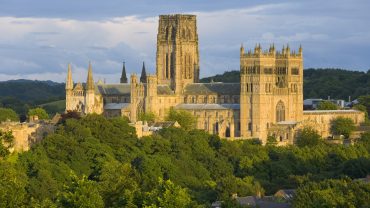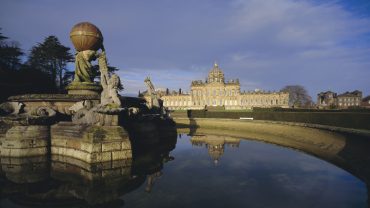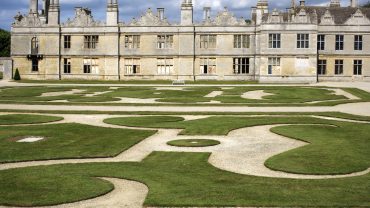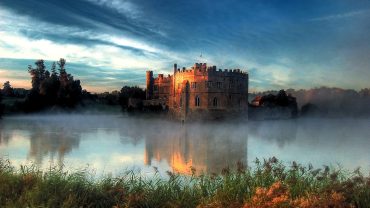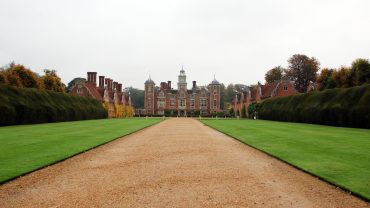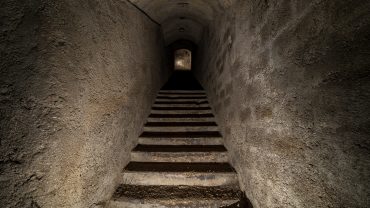Glass has reinvented the way we experience buildings in Britain, evolving from simple window panes to showpieces of engineering and style. Think of the groundbreaking Crystal Palace of 1851, once a shimmering marvel of modular glass and iron, and fast forward to modern icons like The Gherkin or The Shard, which capture daylight and attention with equal force.
Ready to explore how glass buildings have shaped our skyline? Let’s step inside.
A Brief History of Glass Architecture
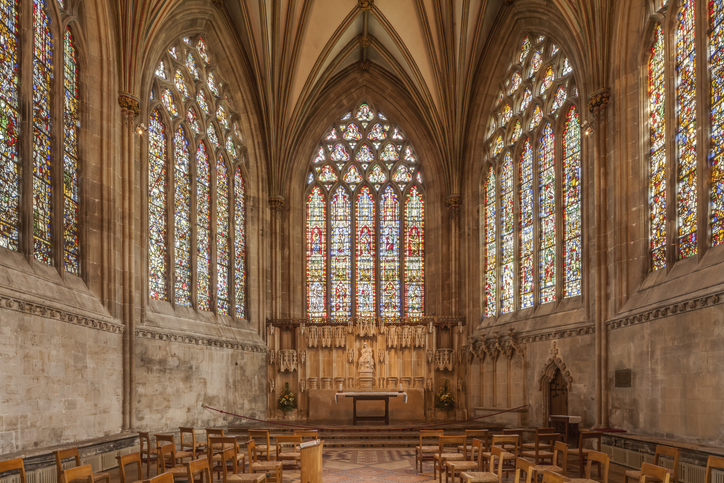
The stunning stained glass in the Lady Chapel in Wells Cathedral (Credit: Julian Elliott Photography via Getty Images)
Glass architecture isn’t simply a modern phenomenon. In fact, it’s featured in architectural design for thousands of years, with its earliest use for ornamentation and window openings noted among both the ancient Egyptians and the Romans.
Medieval Europe saw stained glass transform the interiors of Gothic cathedrals with luminous storytelling, and by the nineteenth century, advances in manufacturing ushered in the era of glasshouses and grand exhibition halls. The twentieth century then marked a revolution in UK glass architecture and production, where the invention of float glass by Sir Alastair Pilkington in the 1950s made expansive, flawless sheets possible for modern build projects. Today, glass architecture is prominent in some of the UK’s most iconic buildings, not just for its striking aesthetics, but for its unique practical advantages.
St Pancras Station, London
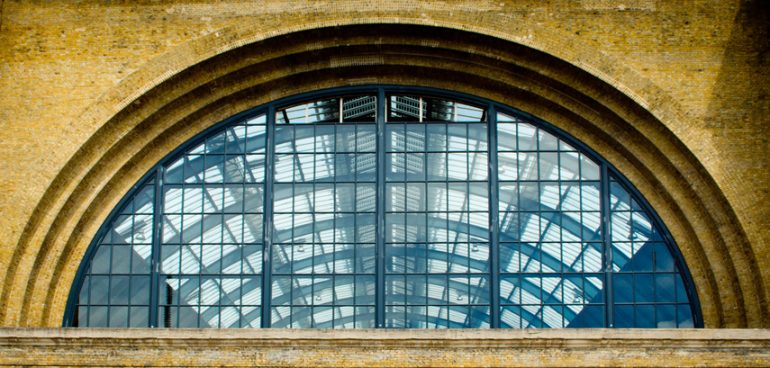
The glass roof of St Pancras Station (Credit: Alphotographic via Getty Images)
The glass roof of St Pancras Station, known as the Barlow Shed, is a triumph of Victorian engineering and one of the most famous examples of glass architecture in the UK. It was named after William Henry Barlow, the Midland Railway engineer who designed much of the station’s original layout. When completed in 1868, it was the largest single-span roof in the world, stretching 210 metres long, 75 metres wide, and 30 metres high.
Its innovative use of glass and iron was considered groundbreaking at the time, enabling the creation of a vast, light-filled space unlike any other railway terminus of the era. The roof contains thousands of individually shaped glass panels, each uniquely manufactured to fit the complex curvature of the structure. The impressive scale means it spans roughly the length of two football pitches, supported by 690 cast-iron columns.
During the station’s twenty-first century restoration, the original glazing was updated with over 10,000 square metres of modern glass, made up of around 18,000 self-cleaning panes, to maximise daylight and to create a welcoming atmosphere for the thirty six million passengers who use the station every year.
Today, it stands as one of the world’s most recognisable railway landmarks and a defining achievement of 19th-century glass architecture.
The Crystal Palace, London
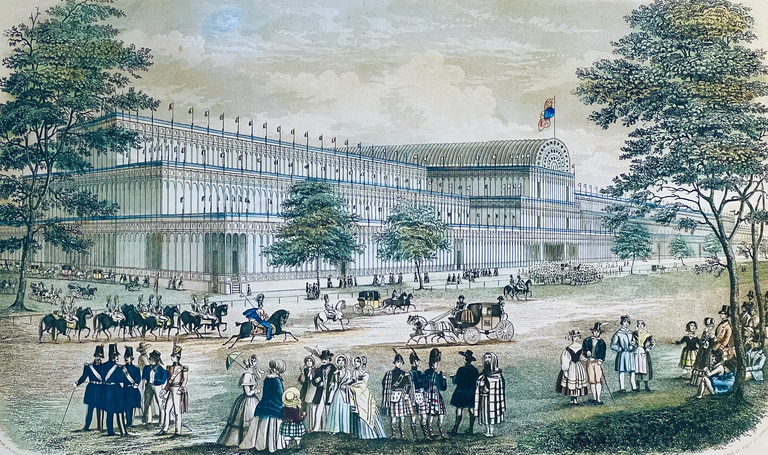
The Crystal Palace in Hyde Park, 1851 (Credit: clu via Getty Images)
The Crystal Palace, built in Hyde Park for the Great Exhibition of 1851, was perhaps the most groundbreaking and iconic of all the glass buildings in Britain. Designed by architect and engineer Joseph Paxton, it was a marvel of industrial prefabrication, stretching 564 metres long and 39 metres high. The palace was constructed in just 39 weeks by over 5,000 workers, using a modular system based on the largest available pane size at the time – 25.4cm by 124.4cm. By comparison, the largest pane size available today is around 20 metres by 3.6 metres.
At its unveiling, the structure stunned visitors with its 293,000 panes of glass weighing over 400,000 kilograms, collectively covering an area of almost 93,000 square metres, or the equivalent area of around thirteen football pitches. The interior of the Crystal Palace was three times the size of St Paul’s Cathedral.
The sheer expanse of glass meant that Crystal Palace required no artificial lighting during daylight hours, embodying a new era in glass architecture. This innovative use of glass and cast iron defined the spirit of progress and possibility at the heart of Victorian Britain. Its dazzlingly monumental scale made the Crystal Palace an instant cultural icon, admired for its audacious ambition and the way it pushed traditional architectural boundaries.
After the Great Exhibition, it was painstakingly – and very carefully – dismantled and moved to an area known as Penge Place on Sydenham Hill in South London. It stood there until it was unfortunately destroyed in a catastrophic fire in November 1936.
The Glasshouse International Centre for Music, Gateshead
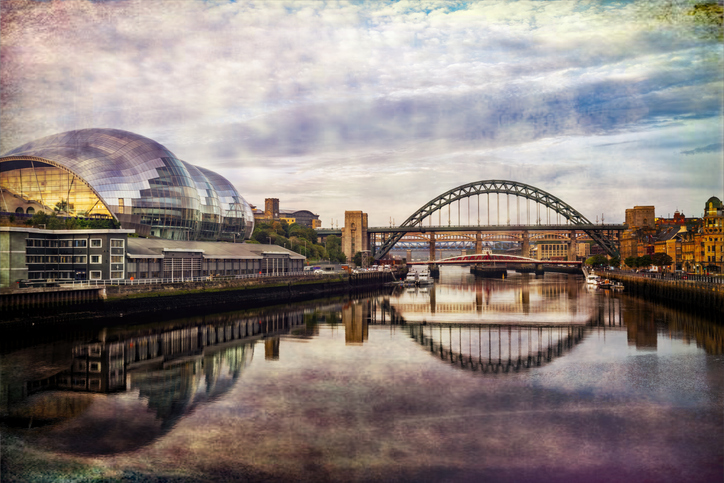
The Glasshouse International Centre for Music (Credit: Alphotographic via Getty Images)
The Glasshouse International Centre for Music in Gateshead was designed by Foster + Partners and opened in 2004. The building’s distinctive curved glass shell floods the interior with natural light and offers amazing views of the River Tyne and surrounding landmarks. A striking glass and steel building, it covers an area of around 20,000 square metres.
The building itself houses three main performance spaces, the largest of which seats 1,640, and is known for world-class acoustics inspired by Vienna’s Musikverein. The design blends architectural beauty with functional innovation, and the centre supports a vibrant musical community, hosting the Royal Northern Sinfonia orchestra and music education programmes. Its sustainable features include natural ventilation and solar shading, making it both an environmental and cultural landmark on the map of the best glass buildings in Britain.
The Gherkin, London
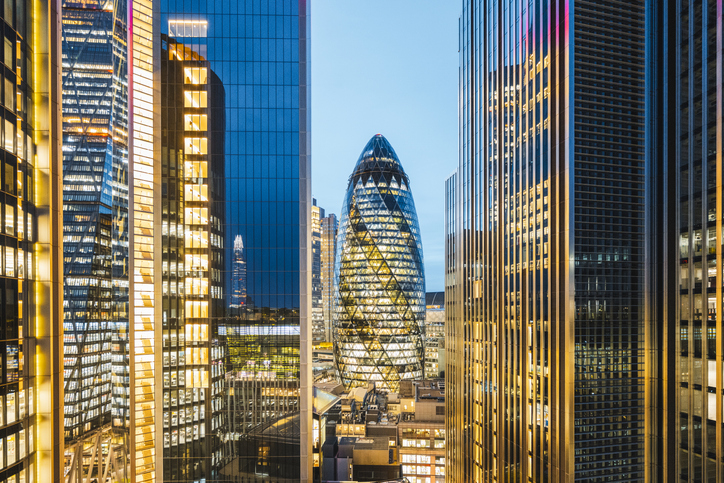
The Gherkin in the City of London (Credit: © Marco Bottigelli via Getty Images)
The Gherkin, officially known as 30 St Mary Axe, is one of London’s most iconic modern skyscrapers and a globally recognised example of best in class UK glass architecture. Designed by Sir Norman Foster and completed in 2004, this 41-story tower stands 180 metres tall, with a distinctive bullet-shaped form clad in a glass and steel diamond-patterned facade.
Located on the site of the former Baltic Exchange, the Gherkin transformed London’s skyline by combining innovative sustainable design with striking aesthetics. Its aerodynamic shape promotes natural ventilation through spiraling light wells, significantly reducing energy consumption and the need for air conditioning.
One of the most famous of all the UK’s glass buildings, The Gherkin is widely celebrated for its architectural innovation and sustainability, winning the prestigious Royal Institute of British Architects Stirling Prize in 2004. Today this iconic structure remains a potent symbol of modern London as well as the benchmark for contemporary glass architecture in the city.
Urbis, Manchester
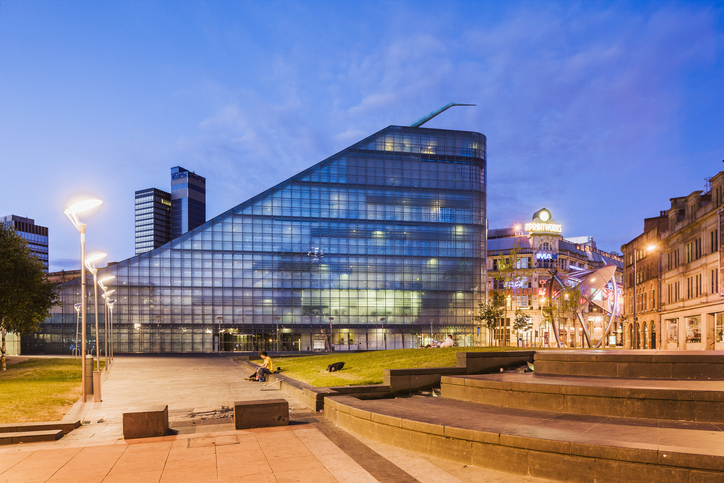
Urbis, home of the National Football Museum (Credit: © Maremagnum via Getty Images)
Urbis, in Manchester’s Cathedral Gardens, was designed by Ian Simpson Architects, and opened in 2002. Rising six storeys high, the building features a distinctive sloping form capped by a 35-metre high roof. Its glass façade comprises around 2,200 panes arranged in horizontal strips, complemented by a pre-aged copper roof that gives the building its unique greenish tint. The design intentionally blends modernity with respect for Manchester’s historic surroundings, including views of the nearby Victoria Station and Manchester Cathedral.
One of the most striking UK glass buildings, it was originally an exhibition centre showcasing urban life around the world, and its internal layout encouraged exploration from the top floor down through mezzanine galleries. Since 2012, Urbis has been home to the National Football Museum.
The Shard, London
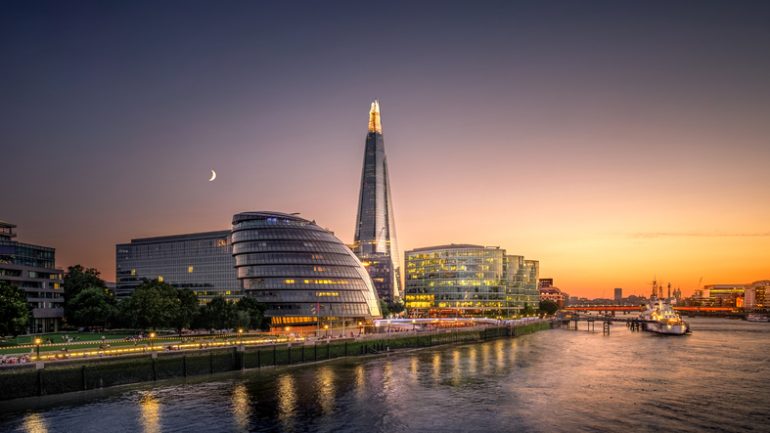
The Shard, with City Hall in the foreground (Credit: Puthipong Worasaran via Getty Images)
The Shard, designed by the renowned architect Renzo Piano and completed in 2012, is the tallest building in the UK at 309.6 metres and is one of the most striking glass buildings in Britain, if not the world. The Shard’s façade consists of 11,000 panes of glass, covering an area of 56,000 square metres, or the equivalent of almost eight Wembley football pitches.
Located beside London Bridge station, the building is a glass-clad pyramid inspired by church spires and ship masts. It’s home to offices, restaurants, apartments, a hotel, and a public observation deck on the 72nd floor offering panoramic views of London.
The Great Glasshouse, Carmarthenshire
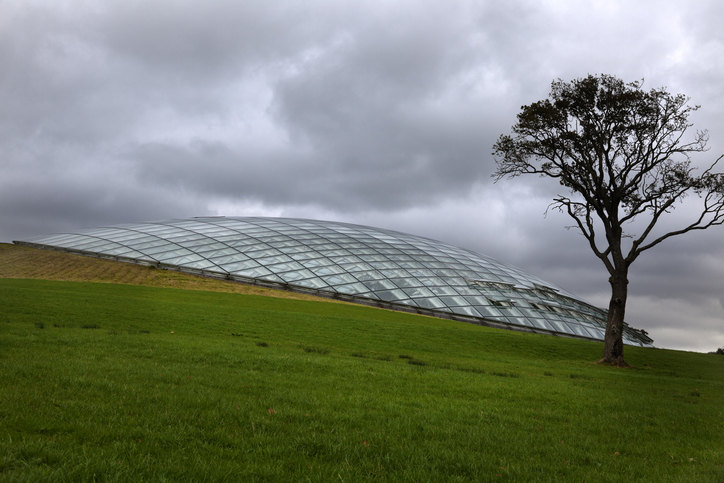
The Great Glass House at National Botanical Gardens Wales (Credit: Pradipkotecha via Getty Images)
The Great Glasshouse at the National Botanic Garden of Wales in Carmarthenshire measures 99 metres long by 55 metres wide, making it the largest single-span glasshouse in the UK and the second only in the world to the Singapore Flower Dome. It is one of the great glass buildings in Britain.
The elliptical roof, supported by twenty-four arches, is designed to maximise sunlight and integrate seamlessly with the surrounding landscape. The structure houses more than a thousand Mediterranean plant species and creates diverse microclimates resembling natural habitats from six climate regions.
Inside, terraced landscapes with sandstone cliffs and gravel slopes create varied growing environments that support an extraordinary range of plants. Sustainable features such as biomass heating, water recycling, and careful climate control underline its role as a cutting-edge, botanical facility which educates visitors about plant conservation and biodiversity.
The Walkie-Talkie, London
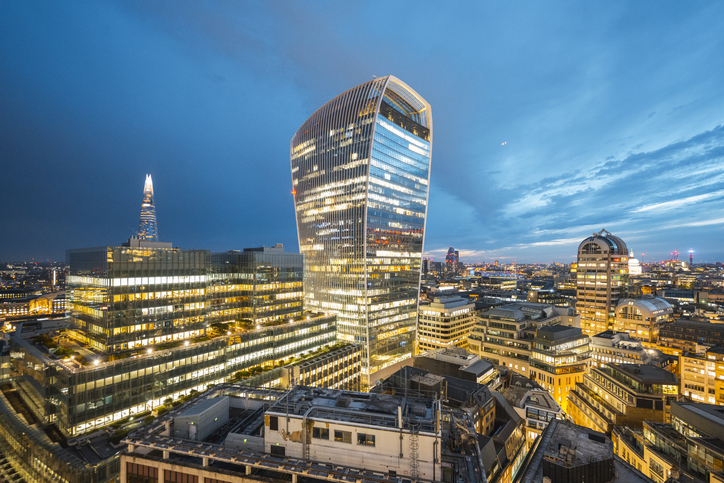
20 Fenchurch Street, also known as the Walkie-Talkie (Credit: © Marco Bottigelli via Getty Images)
Commonly known as the Walkie Talkie, 20 Fenchurch Street is a distinctive 38-floor, 160-metre tall skyscraper, and ranks among tallest buildings in the City of London. Designed by Uruguayan architect Rafael Viñoly and completed in 2014, the tower is famous for its top-heavy, flared profile that widens as it rises, maximising premium office space on the upper floors. Its facade combines fully glazed north and south sides with solar-shading aluminium louvres on the east and west, providing energy efficiency and a unique appearance that stands out on the London skyline.
The Walkie Talkie is best known for its Sky Garden, a public space spanning the top three floors featuring landscaped gardens, restaurants, bars, and unbelievable views of London. The glass-enclosed garden receives abundant natural light through large curved roof panels, however, as examples of glass architecture in the UK go, it certainly divides opinion. One architecture critic described it as having ‘all the finesse of a departure lounge.’ Despite criticism over its unusual shape and effects on the surrounding areas, the Walkie Talkie remains a prominent architectural landmark and one of the most talked-about of the UK’s glass buildings.


